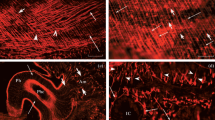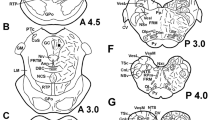Abstract
Immunocytochemistry was performed on the nervous system of Helix by the use of an antibody raised against a myotropic neuropeptide, the catch-relaxing peptide (CARP), isolated from Mytilus edulis. In each ganglion of the central nervous system of Helix pomatia, numerous CARP-immunoreactive cell bodies and a dense immunoreactive fiber system could be observed with a dominancy in the cerebral and pedal ganglia. The majority of the immunoreactive neurons are unipolar, although multipolar neurons also occur. In the neuropil areas, CARP-immunoreactive fibers show extensive arborization, which may indicate a central role of CARP. CARP-immunoreactive elements could be observed in each investigated peripheral nerve and peripheral areas, namely in the intestine, heart, aorta, buccal mass, lips, and foot. However, CARP-immunoreactive cell bodies could only be demonstrated in the intestine and the foot musculature. Thin varicose CARP-immunoreactive fibers were observed over both muscle and gland cells in the different peripheral organs, suggesting a peripheral role of CARP. In vivo CARP injection into the body cavity (10-3, 10-4, 10-5 M) altered the general behavioral state of the animals and induced the relaxation of the musculature of the whole body wall indicating that CARP has a significant role in the regulation of muscle contraction.
Similar content being viewed by others
References
Alevizos A, Weiss KR, Koester J (1987) Myomodulin: a possible contransmitter of the cholinergic neuron L10 of Aplysia. Soc Neurosci Abstr 13:1072
Balaban PM, Litvinov EG (1977) Command neurones in the unconditioned reflex arc of the snail. J Higher Nerv Act 27:538–544
Bullock TH, Horridge GA (1965) Structure and function in the nervous systems of invertebrates. Freeman, San Francisco London
Cottrell GA, Osborne NN (1970) Subcellular localization of serotonin in an identified serotonin-containing neurone. Nature 225:470–472
Cottrell GA, Schot LP, Dockray GJ (1983) Identification and probable role of a single neurone containing the neuropeptide Helix FMRFamide. Nature 304:638–640
Critz SD, Baxter DA, Byrne J (1991) Modulatory effects of serotonin, FMRFamide, and myomodulin on the duration of action potentials, excitability, and membrane currents in tail sensory neurons of Aplysia. J Neurocytol 66:1912–1926
Cropper EC, Lloyd PE, Reed W, Tanenbaum R, Kupfermann I, Weiss KR (1987a) Multiple neuropeptides in cholinergic motoneurons of Aplysia: evidence for modulation intrinsic to the motor circuit. Proc Natl Acad Sci USA 84:3486–3490
Cropper EC, Tenenbaum R, Kolks MAG, Kupfermann I, Weiss KR (1987b) Myomodulin: a bioactive neuropeptide present in an identified cholinergic buccal motor neuron of Aplysia. Proc Natl Acad Sci USA 84:5483–5486
Elekes K (1991) Serotonin-immunoreactive varicosities in the cell body region and neural sheath of the snail, Helix pomatia, ganglia: an electron microscopic immunocytochemical study. Neuroscience 42:583–591
Fujisawa Y, Kubota I, Kanada T, Kuroki Y, Muneoka Y (1991) Neuropeptides isolated from Mytilus edulis (Bivalvia) and Fusinus ferrogineus (Prosobranchia). In: Florey E, Stefano GB (eds) Comparative aspects of neuropeptide function. Manchester University Press, Manchester, pp 97–114
Fujiwara-Sakata M, Kobayashi M (1992) Neuropeptides regulate the cardiac activity of a prosobranch mollusc, Rapana thomasiana. Cell Tissue Res 269:241–247
Fujiwara-Sakata M, Muneoka Y, Kobayashi M (1991) Action and immunoreactivity of neuropeptides in the buccal neuromuscular system of a prosobranch mollusc, Rapana thomasiana. Cell Tissue Res 264:57–62
Halasy K, Benedeczky I, Fekete E, Gabriel R (1988) Enteric neuromuscular junctions: comparison of ultrastructural features in different phylogenetic groups. Neuroscience 25:147–162
Hernádi L (1991a) Innervation of the vessel system of gastropod CNS by serotonin, FMRF-amide and CARP containing fibers. European J Neuroscience [Suppl] 4:1114p
Hernádi L (1991b) A new double labelling technique of the serotonergic neurons in wholemount preparations of the snail Helix pomatia. Acta Biol Hung 42:417–423
Hernádi L (1992b) Somatotopic representation of the head areas in the cerebral ganglion of the snail Helix pomatia. Acta Biol Hung 43:221–230
Hernádi L (1992b) Relationships between the distribution of serotonergic cell bodies and the running of vascular elements in the central nervous system of the snail, Helix pomatia. Comp Biochem Physiol [A] 103:85–92
Hernádi L, Elekes K (1993) Peptidergic and aminergic centers in the Helix cerebral ganglia: somatotopy and immunocytochemistry. Acta Biol Hung 44:89–92
Hernádi L, Kemenes Gy, Salánki J (1984) Central representation and functional connections of afferent and efferent pathways of Helix pomatia lip nerves. Acta Biol Hung 35:49–65
Hernádi L, Elekes K, S-Rózsa K (1989) Distribution of serotonincontaining neurons in the central nervous system of the snail Helix pomatia. Comparison of immunocytochemical and 5,6-dihydroxytryptamine labelling. Cell Tissue Res 257:313–323
Hirata T, Kawahara A, Muneoka Y (1986) Relaxing and inhibitory actions of pedal ganglion extracts on the anterior byssus retractor muscle of Mytilus. Hiroshima J Med Sci 35:397–402
Hirata T, Kubota I, Takabatake I, Kawahara A, Shimamoto N, Muneoka Y (1987) Catch-relaxing peptide isolated from Mytilus pedal ganglia. Brain Res 422:374–376
Hirata T, Kubota I, Imada M, Muneoka Y, Kobayashi M (1989a) Effects of the catch-relaxing peptide on molluscan muscles. Comp Biochem Physiol [C] 92:283–288
Hirata T, Kubota I, Imada M, Muneoka Y (1989b) Pharmacology of relaxing response of Mytilus smooth muscle to the catch-relaxing peptide. Comp Biochem Physiol [C] 92:289–297
Juhos S, Hiripi L, Elekes K (1993) Biochemical characterization of a serotonergic system in the neural sheath of Helix ganglia. Acta Biol Hung 44:83–87
Kanda T, Kuroki Y, Kubota I, Muneoka Y, Kobayashi M (1990) Neuropeptides isolated from the ganglia of a prosobranch mollusc, Fusinus ferrugineus. In: Yanaihara N (ed) Peptide chemistry 1989. Protein Research Foundation, Osaka, pp 39–44
Kiss T (1988) Catch-relaxing peptide (CARP) decreases the Capermeability of snail neuronal membrane. Experientia 44:988–1000
Kiss T, Osipenko N (1991) Oposite effects of molluscan neuropeptides CARP and MIP on LVA Ca-currents in Helix pomatia L. neurons. Comp Biochem Physiol [C] 99:21–27
Kobayashi M, Muneoka Y (1990) Structure and action of molluscan neuropeptides. Zool Sci 7:801–814
Lesser W, Greenberg MJ (1993) Cardiac regulation by endogenous small cardioactive peptides and FMRFamide-related peptides in the snail Helix aspersa. J Exp Biol 178:205–230
Liu GJ, Santos DE, Takeuchi H (1991) Mapping study of Achatina giant neurons sensitive to molluscan peptides. Comp Biochem Physiol 100:553–558
Miller MW, Alevizos A, Cropper EC, Vilim FS, Karagogeos D, Kupfermann I, Weiss KR (1991) Localization of myomodulin-like immunoreactivity in the central nervous system and peripheral tissues of Aplysia californica. J Comp Neurol 314:627–644
Moffett SB (1991) Reinnervation controls regeneration of target organs in the snail Melampus. In: Kits KS, Boer HH, Joosse J (eds) Molluscan neurobiology. North-Holland, Amsterdam, pp 168–173
Nässel DR, Elekes K (1984) Ultrastructural demonstration of serotonin-immunoreactivity in the nervous system of an insect (Calliphora erythrocephala). Neurosci Lett 48:203–210
Peters M, Altrup U (1984) Motor organization in pharynx of Helix pomatia. J Neurophysiol 52:389–409
Rosen SC, Susswein EC, Cropper EC, Weiss KR, Kupfermann I (1989) Selective modulation of spike duration by serotonin and the neuropeptide FMRFamide, SCPB, buccalin and myomodulin in different classes of mechanoafferent neurons in the cerebral ganglion of Aplysia. J Neurosci 9:390–402
Schmalz E (1914) Zur Morphologie des Nervensystems von Helix pomatia. Z Wiss Zool 111:506–568
Schulze H, Speckmann EJ, Kuhlmann D, Caspers H (1975) Topography and bielectrical properties of identifiable neurones in the buccal ganglion of Helix pomatia. Neurosci Lett 1:277–281
S-Rózsa R, Zhuravlev V (1981) Central regulation and coordination of the activity of cardio-renal system and penumostoma in the suboesophageal ganglia of Helix pomatia L. Comp Biochem Physiol [A] 69:85–98
Sternberger LA (1979) Immunocytochemistry, Wiley, Chichester
Vilim FS, Cropper EC, Alevizos A, Tenenbaum R, Kupfermann I, Weiss KR (1989) Structure determination and cellular localization of a novel myomodulin related octapeptide in Aplysia. Soc Neurosci Abst 15:665
Yanagawa M, Fujiwara M, Takabatake I, Muneoka Y, Kobayashi M (1988) Potentiating effects of some invertebrate neuropeptides on twitch contraction of radula muscles of a mollusc Rapana thomasiana. Comp Biochem Physiol [C] 90:73–77
Author information
Authors and Affiliations
Rights and permissions
About this article
Cite this article
Hernádi, L., Terano, Y., Muneoka, Y. et al. Distribution of catch-relaxing peptide (CARP)-like immunoreactive neurons in the central and peripheral nervous system of Helix pomatia . Cell Tissue Res 280, 335–348 (1995). https://doi.org/10.1007/BF00307806
Received:
Accepted:
Issue Date:
DOI: https://doi.org/10.1007/BF00307806




